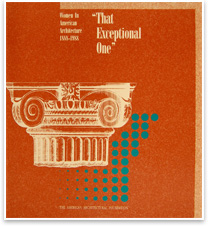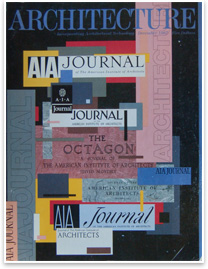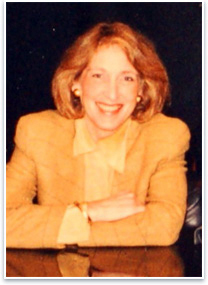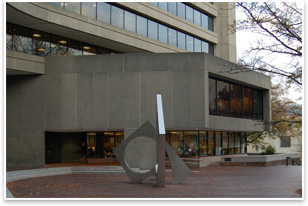

by Tony P. Wrenn, Hon. AIA
Contributing Editor
Summary: 1987 heralded a decade of public
outreach, as the Institute joined with world
leaders—Presidents Reagan, Bush, and Clinton and Prince
Charles—in acknowledging the public power and promise of
architecture. It also marked the centennial celebration of the
first woman member of the AIA, Louise Bethune; the first woman
president of the AIA, Susan Maxman, FAIA; and the first woman
chancellor of the College of Fellows, L. Jane Hastings, FAIA. The
decade saw the AIA embracing diversity in a broader sense, also, in
the form of a national diversity conference. This also was the time
when the AIA was heavily involved in the passage of the Americans
with Disabilities Act—and used advance teleconferencing
techniques to support its implementation—and became an ardent
supporter of the Greening of the White House, antismoking
legislation, and health-care reform.
***
As the decade begins and the Institute increased efforts to involve
the public in architecture, a handsome booklet, The American
Institute of Architects: The Organization’s Role, History, and
Activities, suggested that “more than any other art form,
architecture touches our lives. We live, work and play in and
around buildings. And all these buildings affect our health,
safety, and well-being. Architects shape our environment.” The
booklet covers Institute history, 1857-1987, in three paragraphs,
stressing that “Today, architecture is a respected
profession” of some 44,000 men and women in almost 300 state
societies and chapters stretching from Maine to Guam.”
The Octagon, separated from the Institute’s Modern seven-story
headquarters by a quiet garden, “restored to the elegance of
its original design,” is open to the public without charge,
the booklet continues, and enumerates other AIA advantages:
“the AIA’s library and, by appointment, its archives,
which houses one of America’s most valuable collections of
architectural books, manuscripts, photographs, and drawings”;
AIA Honor Awards, “the profession’s highest
acknowledgment of design excellence,” intended to recognize
and encourage good design; Regional/Urban Design Assistance Teams
(R/UDAT) and Quality Environmental Study Teams (QUEST) available to
local communities to encourage use of existing resources and
analyze forces that produce successful urban areas; support of
policy issues, “at every level of government, that affect the
natural and built environment”; and publication of
Architecture magazine, available, with other architectural
publications and objects with an architectural theme, from the AIA
Bookstore. Public queries were invited.
A decade of public outreach
1987 also began a decade of outreach. The first public
unveiling of the design for the Ronald Reagan Presidential Library
was made on January 28 at the kickoff of Grassroots ’87, in
Washington. Grassroots, a leadership training conference, annually
brings staff and officers of AIA chapters and state societies to
Washington. In 1987, Hugh A. Stubbins Jr., FAIA, architect of the
Reagan Library, was present to introduce the library design. In a
taped message from the White House, President Reagan told attendees
“I am very happy to join the long line of presidents who have
renewed a relationship with the American Institute of Architects.
The AIA has been instrumental in ensuring that the nation’s
capital remains true to its historic traditions and its special
place in the hearts of Americans. From your work on the Master
Plans for the Mall and the Capitol to your stewardship of the
Octagon, to your fight to restore the West Front of the U.S.
Capitol, you have served the public interest with
distinction.” Reagan told his listeners “Whenever I
return to the White House by helicopter ... I ... feel the power of
architecture to inspire and delight.”
 New editions
of 12 standard construction documents were issued in 1987,
representing “the most intense and comprehensive drafting
effort in the AIA’s 130-year history.” Although these
were of particular interests to architects, their clients, and
builders, the public was not ignored. America by Design, a
five-part public-television series, looked at houses, workplaces,
streets, public places, monuments, and the land itself “as one
design, made out of whole cloth, continuous over time and
geography.” Hosted by architectural historian Spiro Kostof,
America by Design was three years in the making. In
segments from 30 states, it investigated how “we mark the land
with farms and cities and highways, and what ... these patterns say
about us—who we are, where we have come from, and where we are
going.”
New editions
of 12 standard construction documents were issued in 1987,
representing “the most intense and comprehensive drafting
effort in the AIA’s 130-year history.” Although these
were of particular interests to architects, their clients, and
builders, the public was not ignored. America by Design, a
five-part public-television series, looked at houses, workplaces,
streets, public places, monuments, and the land itself “as one
design, made out of whole cloth, continuous over time and
geography.” Hosted by architectural historian Spiro Kostof,
America by Design was three years in the making. In
segments from 30 states, it investigated how “we mark the land
with farms and cities and highways, and what ... these patterns say
about us—who we are, where we have come from, and where we are
going.”
Envisioning livable cities
In March 1988, the AIA and the Royal Institute of British
Architects (RIBA) hosted a “Remaking Cities” conference
in Philadelphia. There, AIA President Ted A. Pappas, FAIA, said
“The challenge is for architects to get out of their offices
and into the community. The challenge for the community is to stop
waiting for a white knight or a ‘master builder,’ and
take charge of its own future ... Unless the hands of our neighbors
are on our pencils, our art will always be on the periphery of
community life.” RIBA President Roderick P. Hackney also
stressed the need for public/private partnerships. “The
challenge is to re-equip and use as a resource the energy and
enthusiasm of ordinary people waiting to be given new confidence,
new aims, and aspirations to live, work, and invest.”
Prince Charles, heir to the British throne, addressed the closing
conference session: “If we help to recreate places where
people can walk in comfort and security and can look about and be
entertained by buildings that are tuned to the eye, and if we
encourage a renaissance of craftsmanship and the art of
embellishing buildings for man’s pleasure and for the sheer
joy in beauty itself—as opposed to mere
functionalism—then we shall have made our cities the centers
of civilization once again.”
 As a part of a
Vision 2000 effort, the AIA commissioned pollster Louis Harris to
assess public attitudes. When asked to express confidence in
professions, the public ranked architects in second place, behind
doctors, and those polled identified “designing cities that
are livable,” as the most important contribution architects
can make in the next century. “There are high expectations
here,” Harris said. “Seize them.” At a Vision 2000
conference, attended by some 300 architects, educators, social
scientists, journalists, and other professionals, participants
explored technological innovation, changing human values and global
economic realities and creating livable cities. Daniel Boorstin,
former Librarian of Congress, in his keynote address, identified
architects’ prophecies as “embodied in stone.” The
architect needed more than floor plans, he suggested, he needed
“time plans. As a performer on the stage of time, the
architect must predict the future. He must consciously build
receptacles for new functions.” Yet Boorstin stressed that new
monumental buildings whose beauty and function transcend time still
were needed, along with preservation of existing buildings to
“provide ties to our past.”
As a part of a
Vision 2000 effort, the AIA commissioned pollster Louis Harris to
assess public attitudes. When asked to express confidence in
professions, the public ranked architects in second place, behind
doctors, and those polled identified “designing cities that
are livable,” as the most important contribution architects
can make in the next century. “There are high expectations
here,” Harris said. “Seize them.” At a Vision 2000
conference, attended by some 300 architects, educators, social
scientists, journalists, and other professionals, participants
explored technological innovation, changing human values and global
economic realities and creating livable cities. Daniel Boorstin,
former Librarian of Congress, in his keynote address, identified
architects’ prophecies as “embodied in stone.” The
architect needed more than floor plans, he suggested, he needed
“time plans. As a performer on the stage of time, the
architect must predict the future. He must consciously build
receptacles for new functions.” Yet Boorstin stressed that new
monumental buildings whose beauty and function transcend time still
were needed, along with preservation of existing buildings to
“provide ties to our past.”
The exceptional ones
1988 marked the centennial of the election of the first woman
member of the AIA, Louise Blanchard Bethune, FAIA, of Buffalo. A
prominent architect with a successful practice, Bethune was also a
campaigner for women’s rights. Her election centennial was
celebrated with an exhibition “That Exceptional One: Women in
American Architecture, 1888-1988,” which opened to members and
guests at the AIA convention in New York in May, and to the general
public at AIA headquarters in Washington in September. It later
traveled to Boston and, over the next three years, to a number of
other U.S. venues, before being retired to the International
Archives of Women in Architecture (IAWA) at Virginia Polytechnic
Institute, in Blacksburg, Va., along with the notes, graphics, and
other materials gathered as the exhibit was being planned.
Accompanying the historic exhibit was a contemporary exhibit titled
“And Many More: Women in American Architecture,
1978-1988.”
The exhibit title came from an article on architecture students
written by AIA Gold Medalist Pietro Belluschi, FAIA, in 1955. He
could not, he wrote, in “whole conscience recommend
architecture as a profession for girls. I know some women who have
done well at it, but the obstacles are so great that it takes an
exceptional girl to make a go of it. If she insisted on becoming an
architect, I would try to dissuade her. If then, she was still
determined, I would give her my blessing ... she could be that
exceptional one.”
 Membership
records in the AIA Archives were combed to identify women
architects of the 1888-1988 era, and the list appeared in the
exhibition catalog. Contacts made during the creation of a women in
architecture collection at the AIA led to publication of
Architecture: A Place for Women, edited by Ellen Perry
Berkeley and Matilda McQuaid, a series of essays on women in
architecture published by the Smithsonian Institution Press in
1989. That work remains a major source of data on women in
architecture, while the IAWA and AIA Archives collections remain
the two major American sources of information on the subject.
Membership
records in the AIA Archives were combed to identify women
architects of the 1888-1988 era, and the list appeared in the
exhibition catalog. Contacts made during the creation of a women in
architecture collection at the AIA led to publication of
Architecture: A Place for Women, edited by Ellen Perry
Berkeley and Matilda McQuaid, a series of essays on women in
architecture published by the Smithsonian Institution Press in
1989. That work remains a major source of data on women in
architecture, while the IAWA and AIA Archives collections remain
the two major American sources of information on the subject.
Celebrations and anniversaries
In December 1987, Architecture, published in house under
various names since it began publication in 1913, celebrated its
75th year with an issue that looked at the evolution of
architectural publishing and of architecture during the 75 years.
Two months later, the Institute announced sale of its publishing
rights to Billboard Publications. Architecture would
continue to be published in Washington, though not in house, and
would remain the official magazine of the AIA for the next
decade.
 The AIA
Historic Resources Committee (HRC), under various names, turned 100
in 1990, the oldest continuously operating AIA committee. The HRC
celebrated with a three-day conference, “The Role of the
Architect in Historic Preservation: Past, Present, and
Future.” Some 40 scholars, educators, architects, and
preservationists presented papers or participated in panel
discussions. Earlier, the AIA Press had published Recording
Historic Structures, heavily illustrated with photographs and
drawings, which discussed the manner in which historic buildings,
sites, and objects should be recorded, a major interest of the
HRC.
The AIA
Historic Resources Committee (HRC), under various names, turned 100
in 1990, the oldest continuously operating AIA committee. The HRC
celebrated with a three-day conference, “The Role of the
Architect in Historic Preservation: Past, Present, and
Future.” Some 40 scholars, educators, architects, and
preservationists presented papers or participated in panel
discussions. Earlier, the AIA Press had published Recording
Historic Structures, heavily illustrated with photographs and
drawings, which discussed the manner in which historic buildings,
sites, and objects should be recorded, a major interest of the
HRC.
The awarding of the AIA Gold Medal to Fay Jones, FAIA, in 1990
revived the idea of presentation of the medal by the president of
the United States. In an afternoon ceremony on February 22, in the
Roosevelt Room at the White House, President George H. W. Bush
presented the medal to Jones. The audience included all living
recipients of the AIA Gold Medal. Franklin Roosevelt had been the
last president to confer the Gold Medal in the White House when he
presented it to Ragnar Ostberg, Hon. FAIA, in 1933.
 Honors for
Jones continued that evening in an award gala at the National
Building Museum, which culminated a five-day “Accent on
Architecture” celebration. The late Peter Jennings, ABC news
anchor, was master of ceremonies for a glittering banquet event
that included presentation of other AIA awards before some 1,200
guests, including Supreme Court Justices, politicians, Jones and
previous Gold Medalists, and Joan Rivers, Tom Selleck, and Brooke
Shields. Britain’s Prince Charles, the keynote speaker,
praised Gold Medalist Jones for buildings that “speak of
poetry, of architecture in harmony with their natural surroundings.
He has helped put our feet back on the ground. Architecture is for
human beings.” Yet, he continued, “our built environment
seems to reflect the underlying misconception that we are the only
generation on this earth, and that we are here to do with it as we
wish ... The time has surely arrived when we must learn to work
with rather than against nature; when we can once again make places
in which to live and work which are more than machines ... but
which enrich our perceptions of what our being really
is.”
Honors for
Jones continued that evening in an award gala at the National
Building Museum, which culminated a five-day “Accent on
Architecture” celebration. The late Peter Jennings, ABC news
anchor, was master of ceremonies for a glittering banquet event
that included presentation of other AIA awards before some 1,200
guests, including Supreme Court Justices, politicians, Jones and
previous Gold Medalists, and Joan Rivers, Tom Selleck, and Brooke
Shields. Britain’s Prince Charles, the keynote speaker,
praised Gold Medalist Jones for buildings that “speak of
poetry, of architecture in harmony with their natural surroundings.
He has helped put our feet back on the ground. Architecture is for
human beings.” Yet, he continued, “our built environment
seems to reflect the underlying misconception that we are the only
generation on this earth, and that we are here to do with it as we
wish ... The time has surely arrived when we must learn to work
with rather than against nature; when we can once again make places
in which to live and work which are more than machines ... but
which enrich our perceptions of what our being really
is.”
 On July 26,
1990, AIA representatives joined others at the White House as
President Bush signed the Americans with Disabilities Act (ADA).
The AIA had been heavily involved in developing the legislation
and, noted AIA President Sylvester Damianos, FAIA, “architects
will play a vital role in translating the provisions of the ADA
into accessible buildings.”
On July 26,
1990, AIA representatives joined others at the White House as
President Bush signed the Americans with Disabilities Act (ADA).
The AIA had been heavily involved in developing the legislation
and, noted AIA President Sylvester Damianos, FAIA, “architects
will play a vital role in translating the provisions of the ADA
into accessible buildings.”
1991–1992: A series of innovations and
“firsts”
Charles Moore, FAIA, won the AIA Gold Medal in 1991, the same year
his early and innovative work at The Condominium at Sea Ranch,
Calif., which had won an AIA Honor Award in 1967, received the
AIA twenty-five Year Award. It was the first, and perhaps only
time the Gold Medalist has received both honors in the same
year.
Innovation was evident in 1992 when the Institute used video
communications to “explore the promise and demands” of
ADA with architects in more than 200 localities around the country.
The 12-hour, three-part educational series, “Opening All
Doors: Understanding the ADA” used advanced teleconferencing
to allow participants in all 200 localities to hear speakers and
call in questions to be answered on-air.
 A basic
leadership change was evident from 1990 when Susan A. Maxman, FAIA,
of Philadelphia, was elected first vice president/president elect.
She assumed the office in December 1991, and became AIA president
one year later. For the first time in its 134 year history, the AIA
had a woman as its president. Maxman, who headed her own 12-person
firm in Philadelphia, had a long record of service in both the
Pennsylvania Society of Architects, which she had served as
president, and the AIA. Making 1992 a year of the woman, L. Jane
Hastings, FAIA, of Seattle, became the first woman chancellor of
the College of Fellows.
A basic
leadership change was evident from 1990 when Susan A. Maxman, FAIA,
of Philadelphia, was elected first vice president/president elect.
She assumed the office in December 1991, and became AIA president
one year later. For the first time in its 134 year history, the AIA
had a woman as its president. Maxman, who headed her own 12-person
firm in Philadelphia, had a long record of service in both the
Pennsylvania Society of Architects, which she had served as
president, and the AIA. Making 1992 a year of the woman, L. Jane
Hastings, FAIA, of Seattle, became the first woman chancellor of
the College of Fellows.
1993: Two Gold Medalists, licensing laws, and library
upgrades
On January 28, 1993, President Bill Clinton, in his first
White House photo opportunity, presented the AIA Gold Medal to
Kevin Roche, FAIA. Roche, a Modernist and humanist, had just two
days earlier called upon his peers to “create a habitat that
reflects, at last, the aspirations or our democracy.” He
suggested that, in looking at the city “we tend to have ...
myopic vision—we see the monuments, the tree-lined boulevards,
the vibrant avenues; but we do not always see behind those facades
the desolation, the hopelessness of so many.” In April, in a
ceremony at Monticello, Thomas Jefferson was given a posthumous
Gold Medal, the only one of its type ever awarded.
During 1993, the AIA updated information on architecture
registration published in 1950 in The Architect at
Mid-Century, with a new publication Architectural
Licensing Laws: Summary of Provisions. Though in 1950 not all
states had registration laws, by 1993 all did.
 The last
construction change to the exterior of the headquarters building
was completed in 1993 when the AIA library advanced into a new
850-square-foot addition beneath the board room overhang, designed
by Norman Fletcher, FAIA, of TAC, the architect and firm of the
original building. The library occupied the first space on the
right as one entered the building. When opened officially on May 3,
1993, it was noted the expanded library would offer
“conveniences and quality information services to AIA members
as well as students, scholars, the news media, potential
architectural clients, and government agency staffers. The library
and archives had existed since 1857, as material accumulated to be
brought into order by its first professional librarian, hired in
1954, and first archivist, hired in 1980. In 1993, the AIA Library
and Archives had a “full-time staff of nine, including five
librarians and an archivist.”
The last
construction change to the exterior of the headquarters building
was completed in 1993 when the AIA library advanced into a new
850-square-foot addition beneath the board room overhang, designed
by Norman Fletcher, FAIA, of TAC, the architect and firm of the
original building. The library occupied the first space on the
right as one entered the building. When opened officially on May 3,
1993, it was noted the expanded library would offer
“conveniences and quality information services to AIA members
as well as students, scholars, the news media, potential
architectural clients, and government agency staffers. The library
and archives had existed since 1857, as material accumulated to be
brought into order by its first professional librarian, hired in
1954, and first archivist, hired in 1980. In 1993, the AIA Library
and Archives had a “full-time staff of nine, including five
librarians and an archivist.”
Continuing its activist outreach, the AIA supported smoke-free
environmental legislation noting, in testimony before Congress:
“The fact is that environmental tobacco smoke cannot be
totally removed from indoor air except by removing the smoking
itself.” Representatives of the AIA met with President Clinton
in the Oval Office to discuss health-care reform and worked to
develop a feasibility study for President Clinton’s use in his
energy and environmental upgrade and retrofit of the White House
that would lead to its “greening.”
Mid-1990s: Diversity, and diversity in
publications
In 1994, the AIA published the 12th edition of The
Architect’s Handbook of Professional Practice, which had
been updated periodically since 1917 and hosted a national
diversity conference for architects and designers. The three-day
conference was attended by 250 people, who caucused according to
their status or interest as people of color, women,
gay/lesbian/bisexual, youth/student/intern, or disabled and
attended workshops ranging from dealing with harassment and
discrimination to creating a minority design aesthetic.
Also in 1994, the many professional interest area (PIA) newsletters
began publication and AIArchitect was born to replace
Memo. Its publication announcement indicated it would,
“be filled with ... current, late-breaking news vital to our
membership,” and “include member, firm, and component
highlights, regional and PIA news, and monthly news on the
education, practice, government affairs, and legal
fronts.”
At the end of the decade, the contract between Billboard
Publications and the AIA for publication of Architecture
magazine faced renewal negotiations. The 1995 report from
Architecture magazine indicated that in 1994 the magazine
was ranked number one in its field, ahead of both Architectural
Record and Progressive Architecture and maintained a
larger circulation than either. During renewal negotiations, a
request for proposals was drafted and at least five responses were
received by the deadline date in late 1995. Financial comparison
analysis, review of the editorial qualifications of each response,
and feedback from Board members were considered before the
agreement with Billboard was terminated and a new agreement reached
with McGraw-Hill. In January 1997, Architectural Record,
became the magazine of the Institute.
Copyright 2005 The American Institute of Architects. All rights reserved. Home Page
|
AIA150 Rolling History  A Beginning, 1857-1866 A Beginning, 1857-1866 The Second Decade, 1867-1876 The Second Decade, 1867-1876 1877-1886: Westward and Upward 1877-1886: Westward and Upward 1887-1896: A Decade of Outreach, Inclusiveness, and Internationalism 1887-1896: A Decade of Outreach, Inclusiveness, and Internationalism Women and Women Architects in the 1890s Women and Women Architects in the 1890s 1897-1906: The AIA Moves to and Changes Washington 1897-1906: The AIA Moves to and Changes Washington The Institute's Influence on Legislative Policy The Institute's Influence on Legislative Policy At 50, the AIA Conceives the Gold Medal, Receives Roosevelt's Gratitude At 50, the AIA Conceives the Gold Medal, Receives Roosevelt's Gratitude Spinning a Golden Webb Spinning a Golden Webb 1909-1917: The Institute Comes of Age in the Nation's Capital 1909-1917: The Institute Comes of Age in the Nation's Capital 1917-1926: A New Power Structure: World War I, Pageantry, and the Power of the Press 1917-1926: A New Power Structure: World War I, Pageantry, and the Power of the Press 1927-1936: A Decade of Depression and Perseverance 1927-1936: A Decade of Depression and Perseverance The AIA in Its Ninth Decade: 1937-1946 The AIA in Its Ninth Decade: 1937-1946 1947-1956: Wright Recognition, White House Renovation, AIA Closes on 100 1947-1956: Wright Recognition, White House Renovation, AIA Closes on 100 The Tenth Decade: 1957-1966 The Tenth Decade: 1957-1966 1967-1976: New HQ and a New Age Take Center Stage 1967-1976: New HQ and a New Age Take Center Stage A New Home for the AIA in 1973; A Greener Home in 2007 A New Home for the AIA in 1973; A Greener Home in 2007 Diversity and the Profession: Take II Diversity and the Profession: Take II  'The Vietnam Situation Is Hell': The AIA's Internal Struggle over the War in Southeast Asia 'The Vietnam Situation Is Hell': The AIA's Internal Struggle over the War in Southeast Asia 1977-1986: Activism and Capital-A Architecture Are Alive at the AIA 1977-1986: Activism and Capital-A Architecture Are Alive at the AIA 1987-1996 Technology, Diversity, and Expansion 1987-1996 Technology, Diversity, and Expansion |
||
 |
||
|
Captions:
|
||